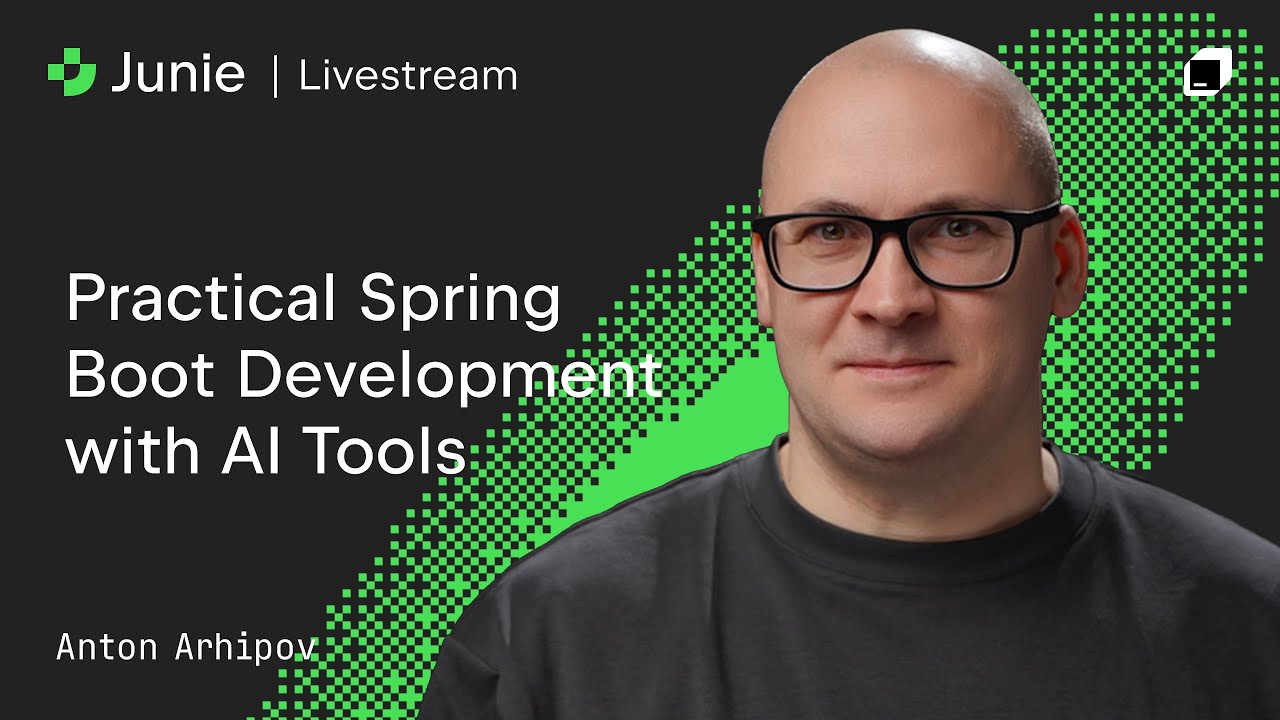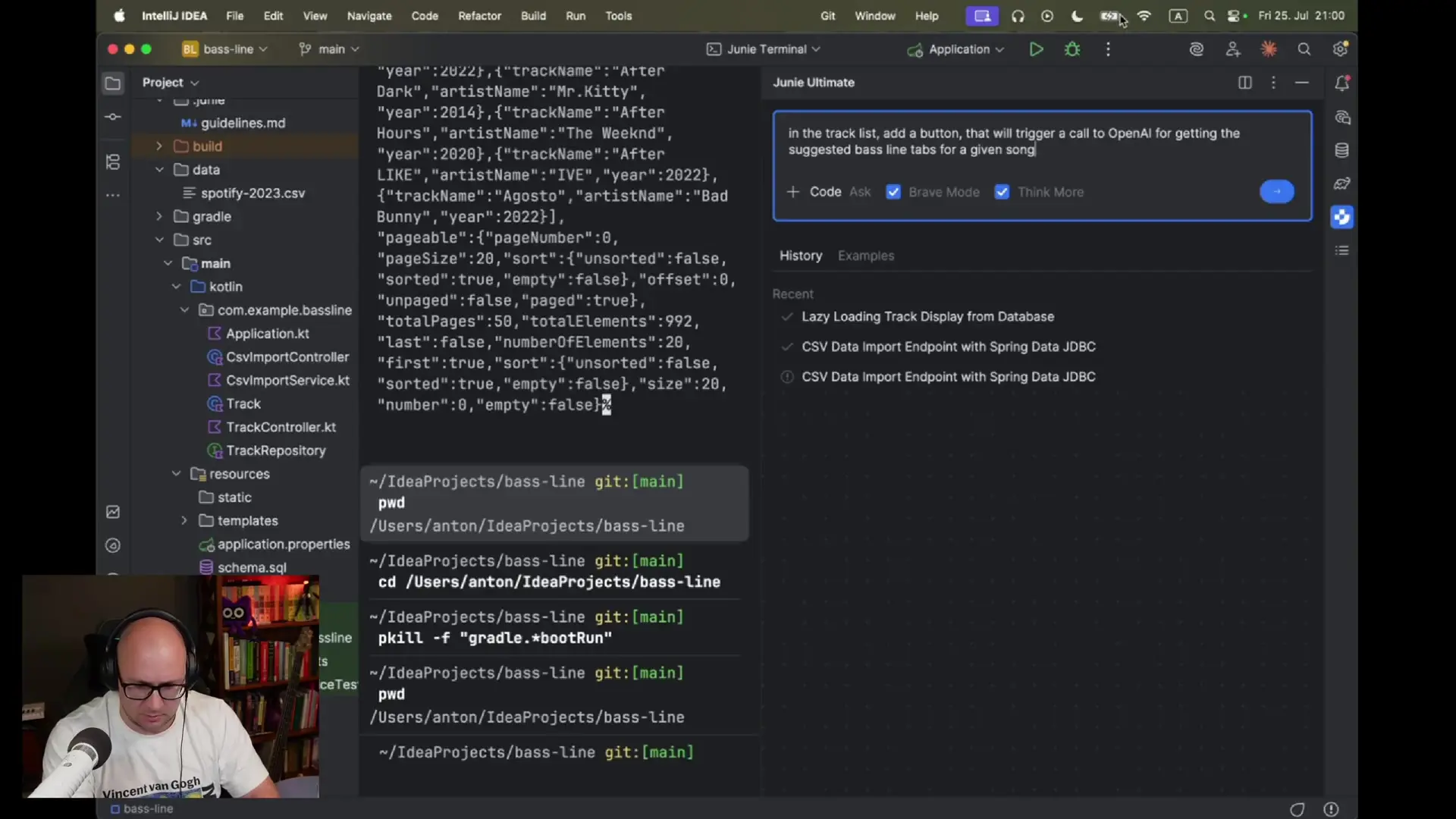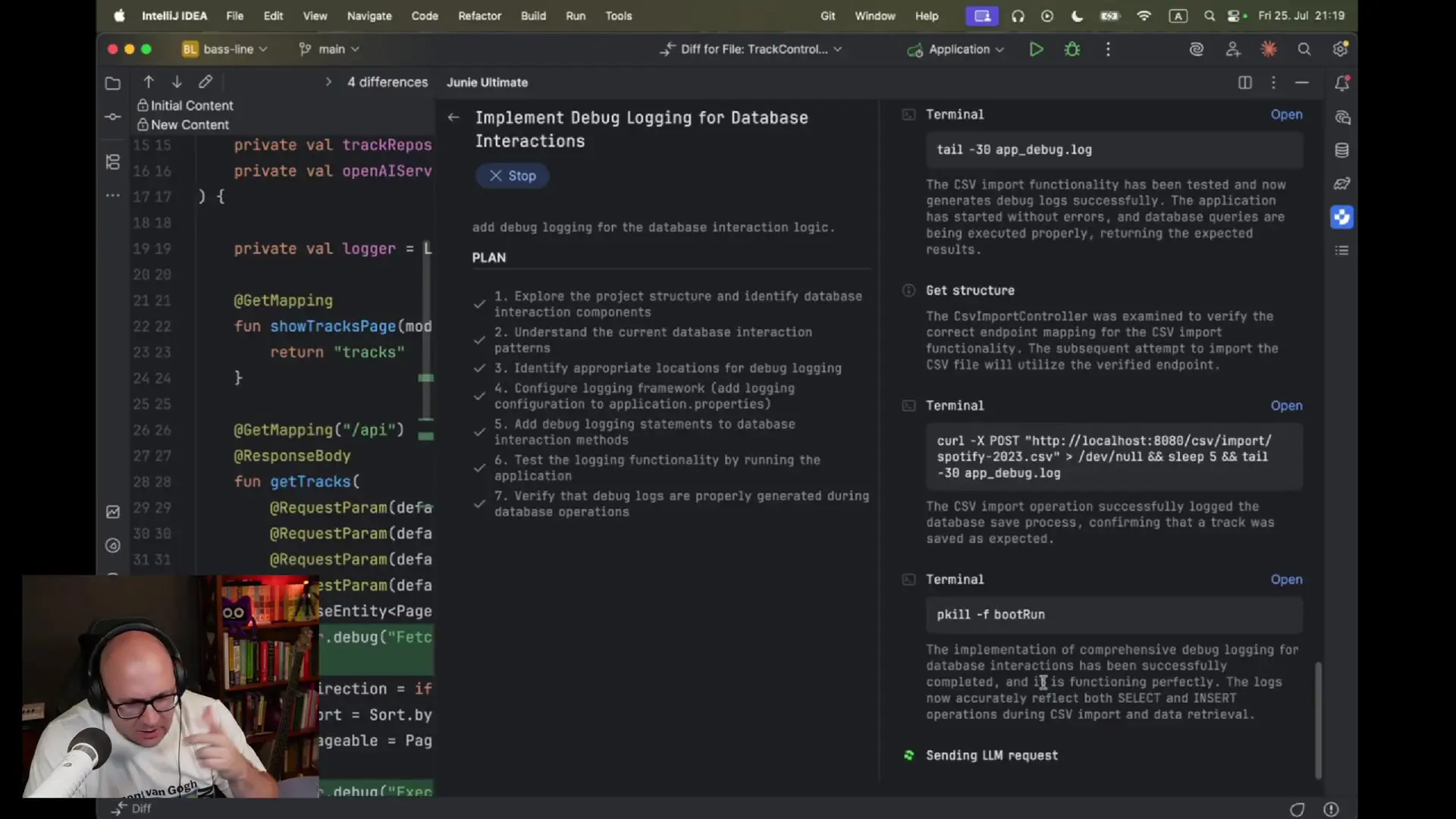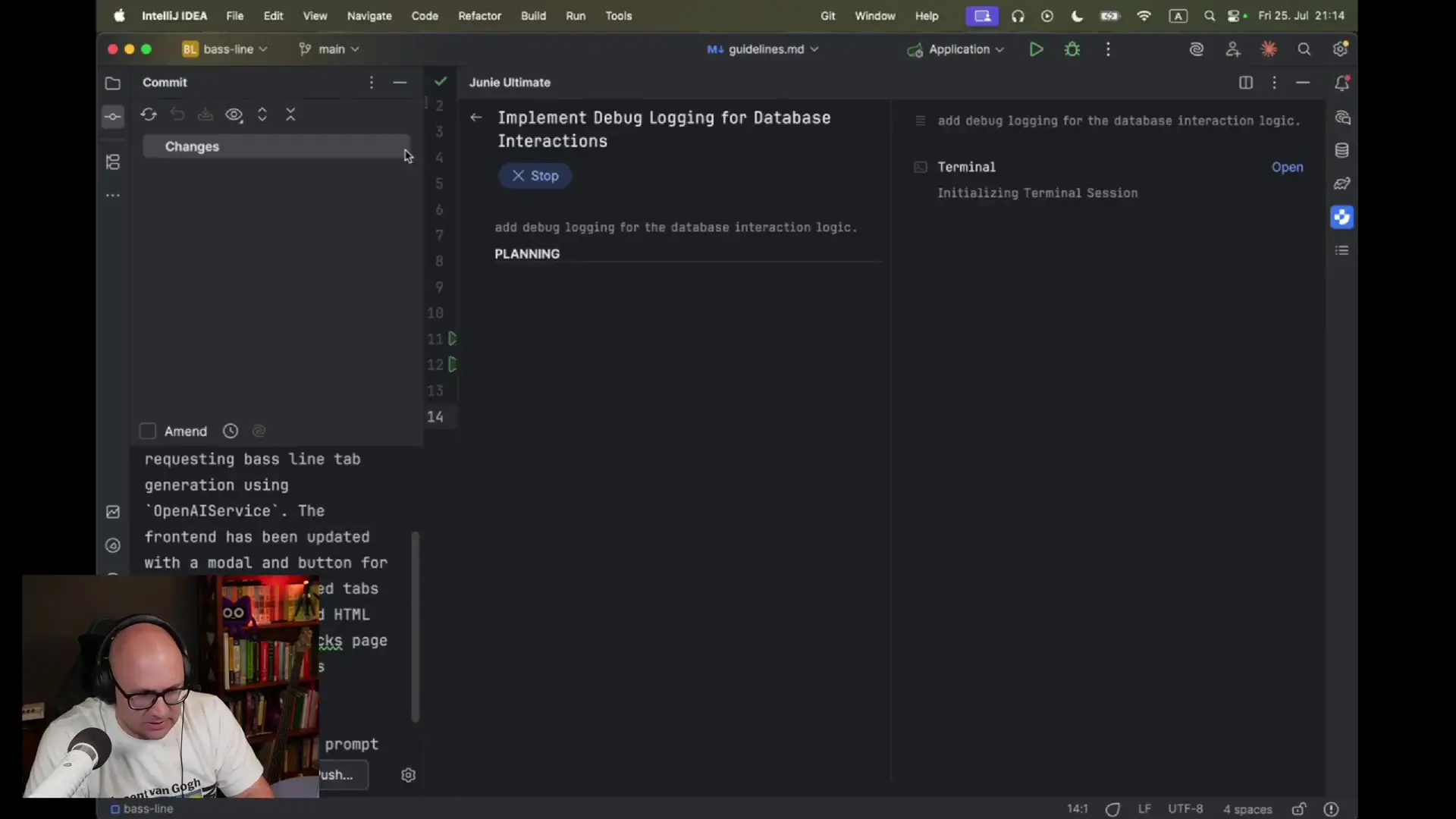
The integration of artificial intelligence with Spring Boot applications is opening new possibilities for developers. In this tutorial, we'll explore how to build a smart music application that processes Spotify song data and uses AI to enhance the user experience. We'll use Kotlin, Spring Data JDBC, and Spring AI to create a practical application that demonstrates the power of AI in Spring-based applications.
Project Overview: Bass Line Generator
Our goal is to build a Spring Boot application that can read Spotify song data from a CSV file, store it in a PostgreSQL database, and then use AI to generate bass line tabs for these songs. This is a practical example of how Spring Boot AI can be applied to create useful tools for musicians.
The application will leverage large language models (like GPT) which have knowledge about popular songs and can generate music-related content. This approach demonstrates how Spring Boot and artificial intelligence can work together to create specialized applications in domains like music.
Setting Up the Spring Boot Project
Let's start by creating a new Spring Boot project with Kotlin. We'll need several dependencies to make our application work:
- Spring Web for creating web endpoints
- Spring Data JDBC for database operations
- PostgreSQL driver for database connectivity
- Spring AI for OpenAI integration
- Docker Compose support for development environment
Using Spring Initializr or your IDE, create a new Kotlin project with Gradle and Java 21. Name it something descriptive like "bassline" to reflect its purpose of generating bass lines for songs.
// Main application class
package com.example.bassline
import org.springframework.boot.autoconfigure.SpringBootApplication
import org.springframework.boot.runApplication
@SpringBootApplication
class Application
fun main(args: Array<String>) {
runApplication<Application>(*args)
}Working with Spotify Data
For our application, we'll use a CSV file containing Spotify song data from 2023. This dataset includes information like track names, artists, stream counts, and other metadata. Before building our application, it's helpful to explore this data to understand its structure.
Kotlin notebooks provide an excellent environment for exploring data before integrating it into our application. They allow us to interactively analyze the CSV file, understand its structure, and determine the appropriate database schema.

The advantage of using Kotlin notebooks is that they automatically parse CSV data and map it to appropriate types, making it easier to understand the data structure before creating our database schema.
Setting Up the Database with PostgreSQL
For our database, we'll use PostgreSQL running in a Docker container. Spring Boot's Docker Compose support makes this setup straightforward. When we add the Docker Compose dependency to our project, Spring Boot generates a compose.yaml file that configures a PostgreSQL instance for us.
This approach simplifies database setup for development and ensures consistency across different environments. After starting the container, we can connect to the database using the preconfigured credentials.
# Docker Compose configuration for PostgreSQL
services:
postgres:
image: 'postgres:latest'
environment:
- 'POSTGRES_DB=mydatabase'
- 'POSTGRES_PASSWORD=secret'
- 'POSTGRES_USER=myuser'
ports:
- '5432:5432'Creating the Database Schema
After analyzing our CSV data, we need to create a database schema to store the Spotify track information. We can use Spring Boot AI to help generate an appropriate schema based on our data structure.
CREATE TABLE spotify_tracks (
id SERIAL PRIMARY KEY,
track_name VARCHAR(255) NOT NULL,
artist_name VARCHAR(255) NOT NULL,
artist_count INTEGER,
released_year INTEGER,
released_month INTEGER,
released_day INTEGER,
streams BIGINT,
bpm INTEGER,
key VARCHAR(10),
mode VARCHAR(10),
danceability_percent INTEGER,
valence_percent INTEGER,
energy_percent INTEGER,
acousticness_percent INTEGER,
instrumentalness_percent INTEGER,
liveness_percent INTEGER,
speechiness_percent INTEGER
);This schema captures all the important attributes from our Spotify dataset, including track details, artist information, release dates, stream counts, and audio features that describe the characteristics of each song.
Implementing CSV Data Import
Now that we have our database schema, we need to implement the functionality to import data from the CSV file into our PostgreSQL database. We'll create a service class to handle this task.

package com.example.bassline.service
import org.springframework.jdbc.core.JdbcTemplate
import org.springframework.stereotype.Service
import java.io.BufferedReader
import java.io.FileReader
@Service
class DataImportService(private val jdbcTemplate: JdbcTemplate) {
fun importSpotifyData(filePath: String) {
val reader = BufferedReader(FileReader(filePath))
var line: String? = reader.readLine() // Skip header
while (reader.readLine().also { line = it } != null) {
line?.let { processLine(it) }
}
reader.close()
}
private fun processLine(line: String) {
val values = line.split(",")
// Handle CSV parsing and database insertion
// Map CSV columns to database fields
}
}Integrating Spring AI with OpenAI
The most exciting part of our application is the integration with AI to generate bass line tabs. Spring AI provides a straightforward way to integrate with OpenAI's models. We'll create a service that uses the Spring AI OpenAI client to generate bass tabs based on song information.

package com.example.bassline.service
import org.springframework.ai.openai.OpenAiChatClient
import org.springframework.ai.openai.api.OpenAiApi
import org.springframework.ai.chat.prompt.Prompt
import org.springframework.ai.chat.prompt.SystemPrompt
import org.springframework.stereotype.Service
@Service
class BassTabService(private val openAiChatClient: OpenAiChatClient) {
fun generateBassTab(trackName: String, artistName: String): String {
val systemPrompt = SystemPrompt("You are a professional bassist who creates bass tabs for songs.")
val userPromptContent = """Generate a bass tab for the song '$trackName' by '$artistName'.
Include the main bass line for the chorus or most recognizable part of the song.
Format it as standard bass tab notation."""
val prompt = Prompt(userPromptContent, systemPrompt)
val response = openAiChatClient.call(prompt)
return response.result.output.content
}
}This service uses Spring AI to communicate with OpenAI, sending a prompt that asks for bass tabs for a specific song. The AI model will generate bass tab notation based on its knowledge of the song.
Creating REST Endpoints
To make our application accessible, we'll create REST endpoints that allow users to interact with our bass tab generator. We'll need endpoints for importing data, retrieving song information, and generating bass tabs.
package com.example.bassline.controller
import com.example.bassline.service.BassTabService
import com.example.bassline.service.DataImportService
import com.example.bassline.service.TrackService
import org.springframework.web.bind.annotation.*
@RestController
@RequestMapping("/api")
class BassLineController(
private val dataImportService: DataImportService,
private val trackService: TrackService,
private val bassTabService: BassTabService
) {
@PostMapping("/import")
fun importData(@RequestParam("filePath") filePath: String): String {
dataImportService.importSpotifyData(filePath)
return "Data import completed"
}
@GetMapping("/tracks")
fun getAllTracks() = trackService.getAllTracks()
@GetMapping("/tracks/{id}")
fun getTrack(@PathVariable id: Long) = trackService.getTrackById(id)
@GetMapping("/tracks/{id}/basstab")
fun getBassTab(@PathVariable id: Long): String {
val track = trackService.getTrackById(id)
return bassTabService.generateBassTab(track.trackName, track.artistName)
}
}Configuration for Spring AI
To use Spring AI with OpenAI, we need to configure our application with the appropriate API key and settings. We'll add these configurations to our application.properties file.
# Database Configuration
spring.datasource.url=jdbc:postgresql://localhost:5432/mydatabase
spring.datasource.username=myuser
spring.datasource.password=secret
# OpenAI Configuration
spring.ai.openai.api-key=${OPENAI_API_KEY}
spring.ai.openai.model=gpt-4
spring.ai.openai.temperature=0.7Note that we're storing the OpenAI API key as an environment variable for security. Make sure to set this variable before running the application.
Benefits of Using Spring Boot AI
Integrating AI capabilities into Spring Boot applications offers several advantages:
- Simplified AI integration through Spring's abstraction layers
- Consistent programming model across different AI providers
- Easy configuration and dependency management
- Seamless integration with other Spring components
- Production-ready features like caching, security, and monitoring
Spring Boot AI makes it easier for Java and Kotlin developers to incorporate artificial intelligence into their applications without having to learn complex AI frameworks or APIs.
Conclusion
In this tutorial, we've explored how to build a smart music application using Spring Boot, Kotlin, and Spring AI. By combining these technologies, we've created an application that can process Spotify song data and generate bass tabs using AI.
This project demonstrates the practical application of AI in Spring Boot applications and shows how easily these technologies can be integrated. As AI continues to evolve, Spring Boot AI provides a solid foundation for building intelligent applications that can enhance user experiences and solve complex problems.
The complete source code for this project can be adapted for various use cases beyond music, such as content generation, data analysis, or natural language processing. The principles demonstrated here can be applied to any domain where AI can provide value to your Spring Boot applications.
Let's Watch!
Building Smart Music Apps with Spring Boot AI and Kotlin
Ready to enhance your neural network?
Access our quantum knowledge cores and upgrade your programming abilities.
Initialize Training Sequence